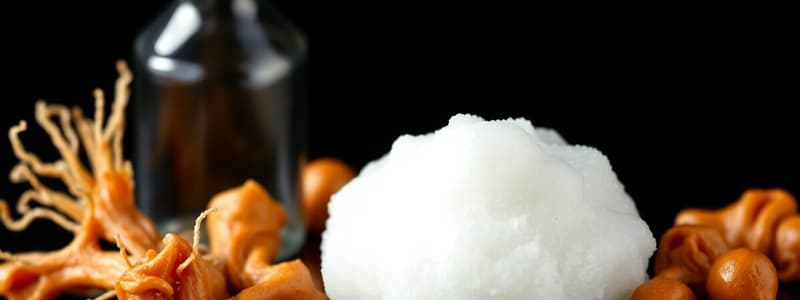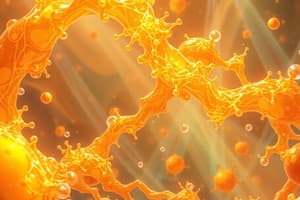Podcast
Questions and Answers
What was the yield percentage of the method involving NaH with a mole ratio of 1.2 and repetition of 2?
What was the yield percentage of the method involving NaH with a mole ratio of 1.2 and repetition of 2?
- 0%
- 65% (correct)
- 76%
- 95%
Which method utilized NaH in DMSO for the dephthaloylation of chitosan derivatives?
Which method utilized NaH in DMSO for the dephthaloylation of chitosan derivatives?
- Method C
- Method A
- Method D
- Method B (correct)
At what temperature was the highest yield (95%) achieved during the dephthaloylation process?
At what temperature was the highest yield (95%) achieved during the dephthaloylation process?
- 80°C
- 100°C (correct)
- 90°C
- 110°C
Which base was found not to have a significant effect on the outcomes as evidenced by the yield data?
Which base was found not to have a significant effect on the outcomes as evidenced by the yield data?
In the context of protection strategies for hydroxy groups, what role does benzylation play?
In the context of protection strategies for hydroxy groups, what role does benzylation play?
What was the observed degree of substitution for the reaction conditions leading to a yield of 76%?
What was the observed degree of substitution for the reaction conditions leading to a yield of 76%?
Which analytical technique was used to compare with the spectral data of derivatives?
Which analytical technique was used to compare with the spectral data of derivatives?
Which method showed a total mole ratio of 6 in the listed reaction conditions?
Which method showed a total mole ratio of 6 in the listed reaction conditions?
What is the purpose of the detritylation process described in the content?
What is the purpose of the detritylation process described in the content?
Which analytical technique was used to quantify the elemental composition of the compound?
Which analytical technique was used to quantify the elemental composition of the compound?
What is the mobile phase used in the HPLC analysis described?
What is the mobile phase used in the HPLC analysis described?
Which spectral technique is primarily used to identify functional groups in the compounds analyzed?
Which spectral technique is primarily used to identify functional groups in the compounds analyzed?
At what temperature was the detritylation process conducted?
At what temperature was the detritylation process conducted?
What was the main solvent used for the deacetylation of chitin?
What was the main solvent used for the deacetylation of chitin?
What is the main purpose of drying solvents before use in chemical reactions?
What is the main purpose of drying solvents before use in chemical reactions?
During the elemental analysis for C34 H33 NO5 ·0.5H2 O, what was the percentage of nitrogen found?
During the elemental analysis for C34 H33 NO5 ·0.5H2 O, what was the percentage of nitrogen found?
What was the main yield percentage of the white powdery material?
What was the main yield percentage of the white powdery material?
Which spectroscopic technique was used to identify the functional groups present in the derivatives?
Which spectroscopic technique was used to identify the functional groups present in the derivatives?
What compound was produced after the benzylation of 6-O-trityl-chitin?
What compound was produced after the benzylation of 6-O-trityl-chitin?
What alkaline treatment method was employed to achieve N-deacetylation of chitosan?
What alkaline treatment method was employed to achieve N-deacetylation of chitosan?
During the synthesis process, what was the temperature at which the reaction mixture was heated for benzylation?
During the synthesis process, what was the temperature at which the reaction mixture was heated for benzylation?
Which functional groups were indicated by the IR spectrum at 3481 cm−1?
Which functional groups were indicated by the IR spectrum at 3481 cm−1?
What was the primary purpose of acetylation performed on isolated chitin?
What was the primary purpose of acetylation performed on isolated chitin?
What catalytic agent was used during the benzylation process of 6-O-trityl-chitin?
What catalytic agent was used during the benzylation process of 6-O-trityl-chitin?
Flashcards are hidden until you start studying
Study Notes
Synthesis of structurally uniform chitin and chitosan derivatives
- Structurally uniform chitin and chitosan are used as starting materials for the synthesis of well-defined derivatives.
- To achieve full N-acetylation, chitin is acetylated.
- Fully N-deacetylated chitosan is prepared through repeated alkaline treatments.
- N-phthaloyl-chitosan is a modified form of chitosan that has been functionalized through the reaction with phthalic anhydride. This process aims to introduce phthaloyl groups into the chitosan structure, enhancing its chemical properties and potential applications. The synthesis involves the use of N-deacetylated chitosan as the precursor, which is obtained through alkaline treatment that removes the acetyl groups present in chitin. The introduction of phthaloyl groups can modify the solubility, biological activity, and reactivity of chitosan, making it suitable for various applications, including drug delivery systems, wound dressings, and as a biodegradable material in environmental applications. The functionalization through phthaloylation significantly boosts its compatibility with other materials and improves its performance in biotechnological and pharmaceutical contexts. is synthesized by reacting N-deacetylated chitosan with phthalic anhydride.
Benzylation of 6-O-trityl-chitin
- 6-O-trityl-chitin is benzylated in the presence of pulverized sodium hydroxide in DMSO.
- The benzylation reaction is not quantitative, even after repeated reactions.
Detritylation of 3-O-benzyl-6-O-trityl-chitin
- Detritylation of 3-O-benzyl-6-O-trityl-chitin is achieved by treatment with a dichloroacetic acid/DMSO (1/1) mixed solvent.
- The deprotection reaction is carried out at room temperature for 1 hour.
- Upon precipitation with acetonitrile/water (4/1), the product is isolated as a pale tan powdery material.
Deacetylation of 3-O-benzyl-6-O-trityl-chitin
- Deacetylation of 3-O-benzyl-6-O-trityl-chitin is performed in 12 mol/L sodium hydroxide at 80°C for 8 hours.
- The resulting product is obtained as a white powdery material.
Dephthaloylation of 3-O-benzyl-2-N-phthaloyl-6-O-trityl-chitosan
- Dephthaloylation is achieved using hydrazine monohydrate at 90°C for 24 hours.
- The deprotection reaction is evaluated at different temperatures (80°C, 90°C, and 100°C).
Solubility of the derivatives
- The solubility of the synthesized chitin and chitosan derivatives is determined in excess of organic solvents at room temperature.
Characterization of the derivatives
- IR spectra are obtained using a Shimadzu FTIR-8900 spectrometer.
- 1H NMR spectra are recorded with a JEOL JNM-LA400D FT-NMR in deuterated dimethyl sulfoxide (DMSO-d6) at 90°C.
- Elemental analysis is conducted with a Perkin-Elmer 2400 II instrument.
- Conductometric titration is carried out with a DKK·TOA CM-20J.
- HPLC is performed with a Waters 486 equipped with a Waters Controller 800, SIM Chromatocorder 21, and a Bondasphere column (5 m, C18, 100A) with a mobile phase of acetonitrile/water (4/1).
Key chemicals employed
- Dimethyl sulfoxide (DMSO) and N,N-dimethylformamide (DMF) are dried with calcium hydride and molecular sieves, respectively, and distilled.
- Pyridine is refluxed with potassium hydroxide and distilled.
- All solvents are stored over molecular sieves.
Studying That Suits You
Use AI to generate personalized quizzes and flashcards to suit your learning preferences.




